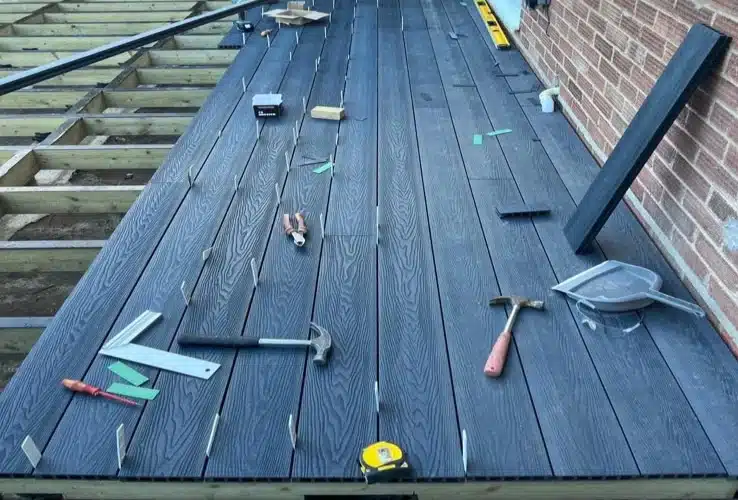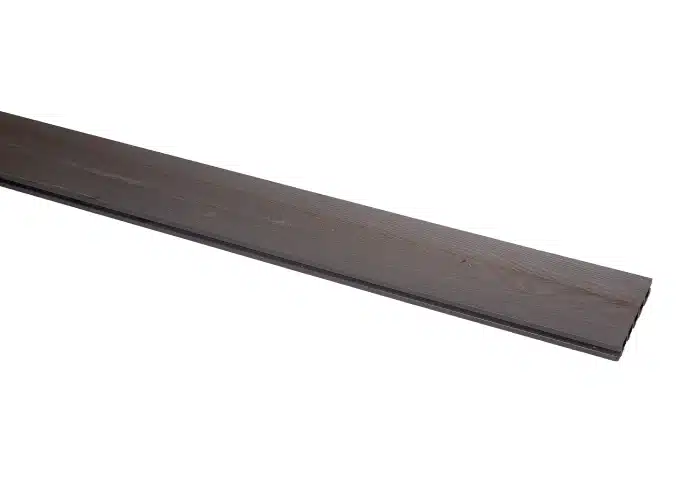How to Build a Flush Ground Level Decking
Vinegar is one of the most commonly used DIY cleaning ingredients among homeowners because it’s relatively cheap and easy to find. And what’s more, you may have some lying around in your kitchen. You will also save more time and money by using vinegar than by buying new cleaning products.
The question is, is it safe to use vinegar on composite decking? How would it affect your composite boards? How can you clean your composite decking with vinegar?
Can You Clean Composite Decking With Vinegar?
Despite being a well-known cleaning ingredient, many still doubt whether they should use vinegar or not. The truth is, while it’s very effective, it’s not a suitable cleaning substitute for all materials. But for composite decking, it is generally safe to use vinegar. However, do not use undiluted vinegar on your decking.
You also don’t want vinegar on your decking for long periods of time. The reason behind this is that vinegar contains acid. That’s the main reason why it can remove stains. But if you leave it out on your decking for a prolonged period, the acid can potentially remove the colour of your decking. Some people even use vinegar to turn their decking into a weathered state.
How Long Can Vinegar Stay On A Deck
In relation to how long you can allow vinegar to sit on your deck before creating any issues is all depending on the dilution of the vinegar used. There are test results online that show undiluted vinegar can cause issues or stains after 24 hours, we ourselves have tested and we can confirm on uncapped boards stains will occur within 12 hours and on capped boards no stains appear even after 24 hours, but our recommendation would be not to allow vinegar to sit beyond 30 minutes, if you do, pay close attention and regularly check the area. If your using to remove a stain or mould we would advise if you plan to allow the vinegar to sit beyond 30 minutes, to first test in a small area which isn’t or less visible to ensure no damage or stains. The reason for this is vinegar can damaged wood, so caution must be taken. In all honestly for dirt and weathered deck, if you pour vinegar or baking soda on the area and clean, you will see results immediately.
So Why Is Vinegar Used?
You can practically find it anywhere, and it’s safe to use. However, you may still want to research whether the material you’ve bought is compatible with vinegar. You may also want to use a commercial cleaning product once in a while since they are better suited for cleaning decking and patios, especially when you’re dealing with more stubborn stains.
So, why is vinegar a commonly used and effective cleaning agent? It is because of the acetic acid that it contains. The acid can dissolve grime and dirt. It is also effective in removing stains. Research also shows that it can kill a range of bacteria, viruses, and other household pathogens, especially when mixed with baking soda.
However, it shouldn’t be used as an alternative to disinfectants, as there are stronger pathogens that can resist vinegar. Make sure to use the proper disinfectant when you want to disinfect a surface.
How to Use Vinegar When Cleaning Decking?
So, vinegar is a safe and affordable substitute for deck cleaning products. But the question is: how do you clean your decking using vinegar? What are the steps to take? Here are some general tips that you can follow to keep your patio clean with vinegar:
1 Gather Your Cleaning Solution & Materials
First, gather all the materials that you will need. You will need 1/2 cup of vinegar, either white or apple cider, 1/4 cup of baking soda, and 3–4 litres of water. Mix all of them in a bucket.
2 Pre-Rinse Your Deck
Next, pre-rinse your decking with water. You can use a garden hose to rinse it faster. Doing this can help remove any dirt and debris on the decking. It also prepares the decking by softening the fibres on your boards. Doing so will allow the solution to work better.
3 Clean The Area With Diluted Vinegar
Then, use a soft-bristle brush and dip it in the solution of vinegar and water. Gently scrub each of the boards. Never use metal brushes, as they can easily graze your decking, leading to more problems.
4 Thoroughly Clean The Area
After washing all the boards, rinse the decking with water. You can use a high-pressure garden hose to remove the solution from your decking. You can also use a pressure washer to rinse the boards. But make sure that you are using a wide tip and that it’s on the prescribed power setting. You may also want to check with the manufacturer first to see if power washing is recommended.
5 What If Stain Hasn't Been Removed
Finally, check for persistent stain spots. For this, you will need to use a stronger solution to remove it. To do this, you will need to mix two parts vinegar and one part water. Apply it directly to the problematic area and sprinkle it with baking soda. Leave it for a few minutes for the vinegar to penetrate the stains. Then, rinse it off with water. If the stain continues then add undiluted vinegar and even baking soda and let sit for 30 minutes, but ensuring to check regularly to ensure no damage, then scrub with a soft brush and clean the solution thoroughly with luke warm water.
Conclusion
As previously mentioned, vinegar as a cleaning agent is cheap and effective. Its great and can be very effective at removing dirt and mould. However, you may want to use a professional cleaning product when it comes to more stubborn stains. Always remember to avoid products with harsh chemicals and test any cleaning products in an inconspicuous area of your decking first.
How Do You Remove Mould From Composite Decking?




